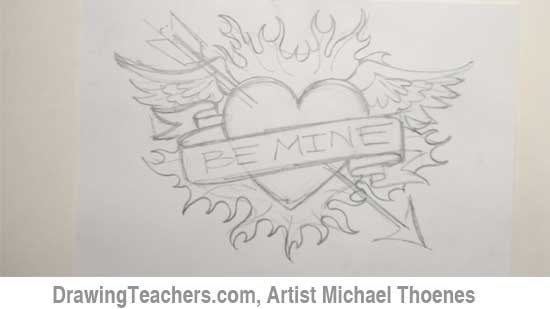
Adjusting the contrast of the LCDĪfter you have wired up the LCD, you will need to adjust the contrast of the display. SDA and SCL pin locations on different Arduino boards. Note that an Arduino Uno with the R3 layout (1.0 pinout) also has the SDA (data line) and SCL (clock line) pin headers close to the AREF pin. If you are not using an Arduino Uno, the SDA and SCL pins can be at a different location. The connections are also given in the table below.

You only need to connect 4 pins instead of 12. Wiring an I2C LCD is a lot easier than connecting a standard LCD. Later in this tutorial, I will show you how you can control the individual pixels to display custom characters on the LCD. If you look closely at the LCD, you can see the small rectangles that form the individual characters of the LCD.Įach rectangle is made up of a grid of 5×8 pixels.
CREATING HEART SKETCH HOW TO
CREATING HEART SKETCH UPGRADE
Luckily, you can also buy the I2C add-on circuit separately on Amazon, so you can easily upgrade a standard LCD as well.įor a tutorial and wiring diagram for standard character LCDs, please see the following article: Standard LCDs typically require around 12 connections, which can be a problem if you do not have many GPIO pins available. You only need two data pins to control the LCD. The advantage of an I2C LCD is that the wiring is very simple.

This module features a PCF8574 chip (for I2C communication) and a potentiometer to adjust the LED backlight. The I2C LCD that we are using in this tutorial comes with a small add-on circuit mounted on the back of the module. This type of LCD is ideal for displaying text and numbers, hence the name ‘character LCD’. This guide is part of our hub of articles on Arduino Displays. As an Amazon Associate we earn from qualifying purchases. is a participant in the Amazon Services LLC Associates Program, an affiliate advertising program designed to provide a means for sites to earn advertising fees by advertising and linking to products on.

(I also have an article on How To Control A Character I2C LCD with ESP32 if you want to work with an ESP32 microcontroller instead). TMP36 analog temperature sensor with Arduino tutorial.LM35 analog temperature sensor with Arduino tutorial.How to use DHT11 and DHT22 Sensors with Arduino.How to use an HC-SR04 Ultrasonic Distance Sensor with Arduino.Other Useful Links From Around The Web:.How to create and display custom characters?.Other useful functions of the LiquidCrystal_I2C library.Installing the LiquidCrystal_I2C Arduino library.How to connect the I2C LCD to Arduino UNO.


 0 kommentar(er)
0 kommentar(er)
